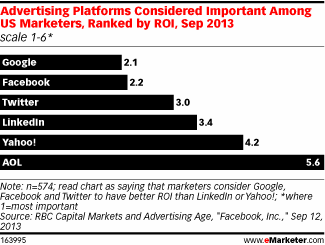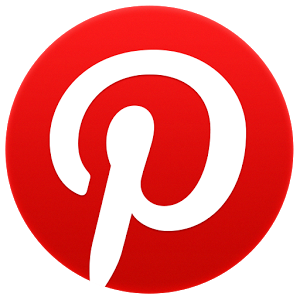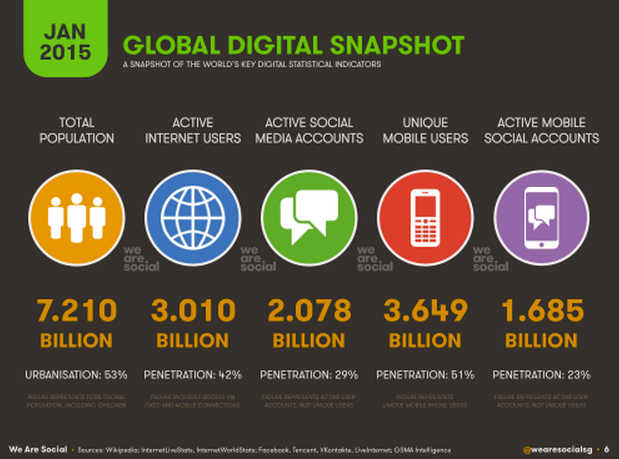Most people are familiar with the major social networks and most are also aware that Facebook dominates the pack in terms of user base size. But do you know just how many people access the platform on a regular basis, or what the global and domestic user totals look like for various other players in the social space?
Today we break down the numbers and explore which channels are most worthy of focusing on from a business perspective.
Social Media Overview
In today’s society, having at least one social media profile is about as common as owning a car or, I dunno, breathing oxygen. A study at the beginning of 2015 found that 2.1 billion people worldwide had at least one active social media account — that’s roughly 30 percent of the global population. You can see that statistic, plus some mobile data, in the graphic below from We Are Social:
These numbers are pretty crazy. Almost half the planet accesses the internet and nearly two out of every three Web users are active on social media. Those figures only continue to rise. This makes it easy to see why nearly 90 percent of brands had some type of social presence last year, with social channels representing three of the top four advertising platforms viewed as most important by marketers in the US.
 Read on, and we’ll break down the user totals for each major social network individually, along with some interesting demographic details.
Read on, and we’ll break down the user totals for each major social network individually, along with some interesting demographic details.
Global Users: 1.4 Billion
Active Daily Users: 936 Million
Active Daily Users in U.S. + Canada: 161 Million
It’s hard to believe that Facebook, first spawned by Mark Zuckerberg a decade ago as a college networking tool, has grown into such a worldwide force. Today Facebook is ubiquitous, thoroughly engrained in our culture to the point that — according to a rather amusing news story from earlier this year — many people in other countries that access Facebook don’t even know what the internet is.
Facebook users are not only numerous, but highly engaged. By and large, they check their feeds frequently, click on interesting links, and interact with brands. Facebook certainly has its drawbacks (particularly in the way it’s run) but there’s no overlooking its place atop the social media kingdom.
Registered Users: 350 Million
Users in the United States: 107 Million
Geographical Reach: 200 countries and territories
LinkedIn is a tough nut to crack. It has a very large user base but not all users are terribly active. It has a strong business slant but brands have struggled to leverage it for marketing. The platform is frequently used for professional networking, recruiting, job hunting and B2B service research. Having a presence here is certainly recommended, especially for companies that are looking to attract high-caliber talent, but engaging and converting through the platform is a murky proposition.
Active Users: 300 Million
Percentage of Mobile Users: 88%
Number of Tweets Published Daily: 500 Million
Personally, Twitter is my preferred social network because it is a pure conversation engine. Users are able to fully customize what shows up in their feed (unlike on Facebook, where an algorithm dictates what you see) and everything is delivered in bite-sized, 140-character morsels. About one out of every three accounts log in more than once per day, and Twitter users are also among the most active from a commerce perspective, shopping online 6.9 times per month compared to 4.3 time per month for non-users.
Google Plus
Active Users: 300 Million
Unique Monthly Visits: 27 Million
Percentage of Brands with G+ Presence: 70%
Google is usually at the forefront of any Web-based trend, but when it came to social media, they were a little late to the party. Although there are technically 2.2 billion Google Plus profiles (they are created automatically for all Google accounts), only 9 percent post public content, and just 4-6 million total users engage and interact on the platform. In short, people don’t really use it for its intended purposes. With that being said, because Plus is so intertwined with the rest of Google’s offerings, maintaining a presence is quite benefical from an SEO and overall digital marketing standpoint.
Active Users: 300 Million
Users in the United States: 77 Million
Photos and Videos Sent Daily: 70 Million
With 53 percent of users falling into the 18-29 age demographic, Instagram is a good tool for connecting with Millenials and other youthful subsets. Brand engagement rates are higher on the media-sharing platform than any other social network, with a 4.21 percent response rate — compare that to the rates on Facebook and Twitter, which are below 0.1 percent. The tricky thing is that because it is essentially a mobile-only app, and it is so media-centric, it’s not a great fit for every type of business.
 Active Users: 73 Million
Active Users: 73 Million
Percentage of Female Users: 68%
Often used to sharing recipes, workouts and crafts, Pinterest has a relatively niche user base but its members are very active and engaged. The average time spent on the site is over 15 minutes, compared to 12 for Facebook and 3 for Twitter. Pinterest users are also fairly well off, with an average houshold income of more than $100 million.
Want to Learn More?
These are just the basics when it comes to the six biggest players in the social media space. If you want to find out more about the inner workings of these networks, and which one(s) might best suit your business, contact us and we’ll be happy to chat with you about your company’s social media strategy!


